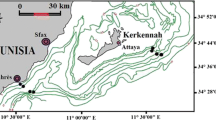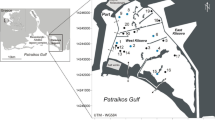Abstract
This study forms part of the Action Plan for the Conservation of Marine Vegetation in the Mediterranean SEa (United Nation Environmental Program). It was carried out in June 2000 in the Farwà Lagoon, Libya. The mapping of the main benthic vegetation was achieved by compiling the field observations (transect method), and remote sensing of SPOT satellite images. The phytobenthos in the Farwà lagoon covers an area of 1820 ha (65%). Three benthic macrophyte species dominate, namely the marine phanerogamsCymodocea nodosa andPosidonia oceanica, and the algaCaulerpa prolifera.
DeadPosidonia oceanica leaves (litter) form veritable mounds in the vicinity of the openings leading to open sea. These leaves, which come from the coastal sea, are brought into the lagoon by currents and tides; their decomposition will lead to high oxygen consumption and the release of hydrogen sulphide.
The phenological data ofPosidonia oceanica shoots sampled in the lagoon are similar to those from other stations in the Mediterranean.
Conversely, the lepidochronological parameters of shoots sampled in the central part of the lagoon exhibit values that are substantially higher than those generally recorded in the Mediterranean. The mean number of leaves produced annually is 9.9 (mean value for the Mediterranean: 7.5) and the rhizome growth rate is of 35.7 mm.yr−1 (mean value for the Mediterranean: 7.5 mm.yr−1). This hypersaline environment would seem to provide optimum growth conditions for the speciesPosidonia oceanica.
Similar content being viewed by others
References
Anon. 1982. Environmental conditions of the Farwà lagoon during 1981.Bull. Mar. Res. Center Tripoli 3: 23–75.
Anon. 1990.Livre rouge ‘Gérard Vuignier’ des végétaux, peuplement et paysages marins menacés de Méditerranée. UNEP/IUCN/GIS Posidonie. UNEP. MAP Technical Reports 43.
Bellan-Santini, D., Lacaze, J.C. & Poizat, C. 1994.Les biocénoses marines et littorales de Méditerranée, synthèse, menaces et perspectives. Muséum National Histoire Naturelle, Secrétariat Faune Flore Publication, Paris, FR.
Belsher, T., Meinesz, A., Lefevre, J.R. & Boudouresque, C.F. 1988. Simulation of Spot satellite imagery for charting shallow water benthic communities in the Méditerranean.Mar. Ecol. P.S.Z.N.I. (Pubblicazioni della Stazioni Zooligica di Napoli) Ser. 9: 157–165.
Boudouresque, C.F., Meinesz, A. & Pergent, G. 1983. Mesure de la production annuelle de rhizomes dans l'herbier àPosidonia oceanica à Port-Cros (Var) et Galeria (Corse).Rapp. P.V. Réun. Comm. Int. Explor. Sci. Médit. 28(3): 135–136.
Boudouresque, C.F., Meinesz, A., Ribera, M.A. & Ballesteros, E. 1995. Spread of the green algaCaulerpa taxifolia (Caulerpales, Chlorophyta) in the Mediterranean: Possible consequences of a major ecological event.Sci. Mar. 59 (Suppl. 1): 21–29.
Calvo, S., Frada Orestano, C. & Abbadessa, P. 1993. The suitability of a topographical instrument for an integrated approach to the cartography ofPosidonia oceanica meadows.Oceanol. Acta 16: 273–278.
Fortes, M.D. 1989. Seagrasses: A resource unknown in the ASEAN région.ICLARM Education Series 5.
Giaccone, G. & Geraci, R.M. 1989. Biogeografia delle alghe del Meditteraneo.An Jard. Bot. Madrid 46: 27–34.
Giraud, G. 1979. Sur une méthode de mesure et de comptage des structures foliaires dePosidonia oceanica (Linnaeus) Delile.Bull. Mus. Hist. Nat. Marseille 39: 33–39.
Guerao, G. & Abello, P., 1996. Patterns of activity in the sympatric prawnsPalaemon adspersus andProcessa edulis (Decapoda, Caridea) from a shallow Mediterranean bay.Sci. Mar. 60: 319–324.
Harmelin-Vivien, M., Harmelin, J.G. & Francour, P., 1996. A 3-year study of the littoral fish fauna of sites colonized byCaulerpa taxifolia in the N.W. Mediterranean (Menton, France). In: Ribera, M.A., Ballesteros, E., Boudouresque, C.F., Gomez, A. & Gravez, V. (eds.),Second International Workshop on Caulerpa taxifolia, pp. 391–397. Publ. Universitat de Barcelona, ES.
Mc Roy, C.P. & Helfferich, C. 1980. Applied aspects of Seagrasses. In: Phillips, R.C. & McRoy, C.P. (eds.)Handbook of seagrass biology: an ecosystem perspective, pp. 297–343. Garland STPM Press, New York, NY.
Pasqualini, V., Pergent-Martini, C., Fernandez, C. & Pergent, G. 1997. the use of airborne remote sensing for benthic cartography: advantages and reliability.Int. J. Remote Sens. 18: 1167–1177.
Pergent, G. 1990. Lepidochronological analysis in the seagrassPosidonia oceanica: a standardized approach.Aquat. Bot. 37: 39–54.
Pergent, G. & Pergent-Martini, C. 1988. Phénologie dePosidonia oceanica (Linnaeus) Delile dans le bassin méditerranéen.Ann. Inst. Océanograph. 64(2): 9–100.
Pergent, G., Pergent-Martini, C. & Boudouresque, C.F. 1995. Utilisation de l'herbier àPosidonia oceanica comme indicateur biologique de la qualité du milieu littoral en Méditerranée: Etat des connaissances.Mésogée 54: 3–29.
Pergent-Martini, C. & Pergent, G. 1995. Lepidochronological analysis in the Mediterranean seagrassPosidonia oceanica: State of the art and future developments.Oceanol. Acta 17: 673–681.
Pergent, G. & Zaouali, J. 1992. Analyse phénologique et lépidochronologique dePosidonia oceanica dans une lagune hyperhaline du Sud Tunisien.Rapp. Comm. Int. Mer Méditerranée 33: 48.
Ramade, F. 1990. Conservation des écosystèmes méditerranéens— Enjeux et perspectives.Les Fascicules du Plan Bleu, PNUE/PAM 3: 1–144.
Author information
Authors and Affiliations
Corresponding author
Rights and permissions
About this article
Cite this article
Pergent, G., Djellouli, A., Hamza, A.A. et al. Characterization of the benthic vegetation in the Farwà Lagoon (Libya). J Coast Conserv 8, 119–126 (2002). https://doi.org/10.1652/1400-0350(2002)008[0119:COTBVI]2.0.CO;2
Received:
Accepted:
Issue Date:
DOI: https://doi.org/10.1652/1400-0350(2002)008[0119:COTBVI]2.0.CO;2




